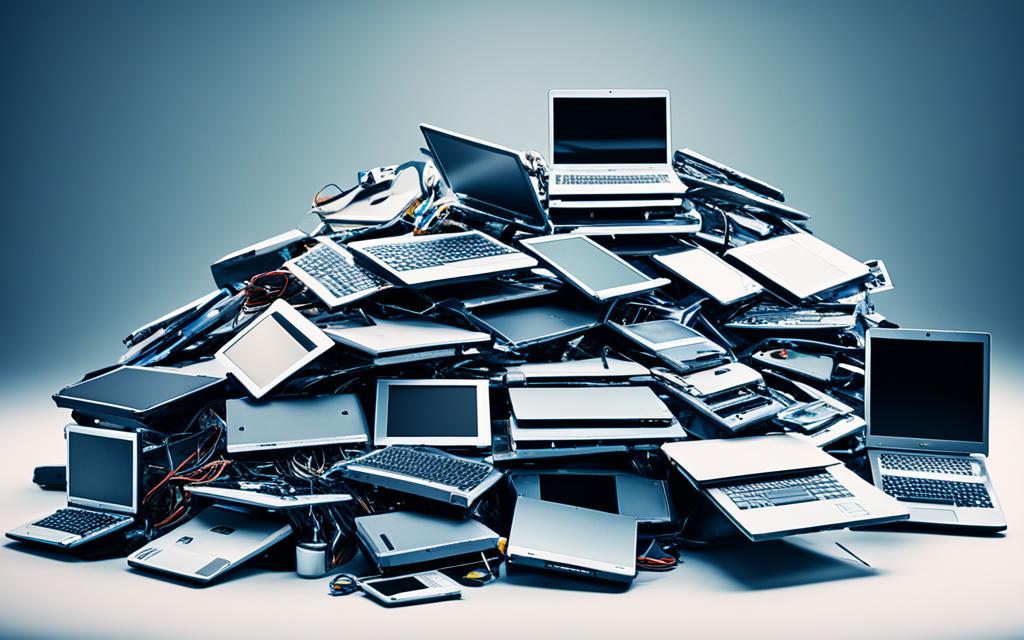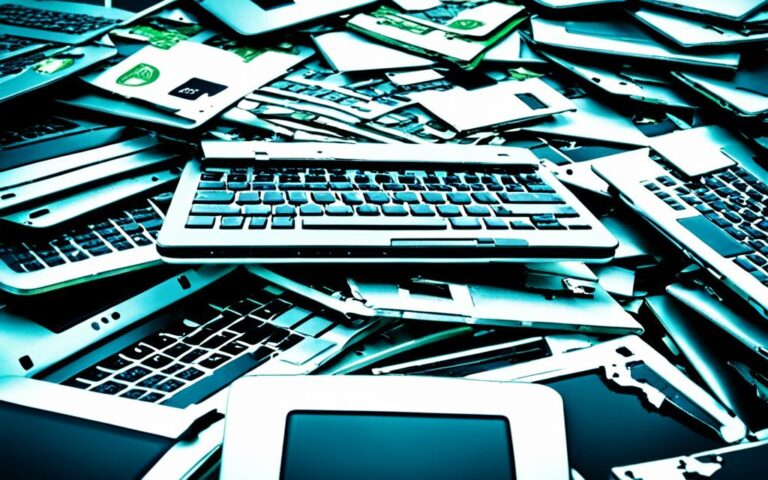The Role of Laptop Recycling in Promoting Digital Inclusion
Laptop recycling plays a crucial role in bridging the digital divide and promoting digital inclusion. It helps manage e-waste sustainably by refurbishing and recycling donated technologies. This not only increases access to affordable technology but also reduces the strain on landfills and prevents the release of toxic substances into the environment.
In today’s digital age, access to technology is essential for individuals and communities to thrive. Unfortunately, many individuals and communities face barriers to technology access, resulting in a digital divide. By recycling laptops and other electronic devices, we can contribute to narrowing this divide and promoting digital inclusion for all.
Understanding the Digital Divide
The digital divide encompasses the inequalities in accessing technology and the internet. It represents the economic, educational, and social limitations faced by individuals without computers and online access. Bridging this divide is crucial to ensure equal opportunities and digital inclusion for all.
According to the Pew Research Center, a significant portion of adults in the United Kingdom still do not use the internet. In fact, the latest data reveals that approximately 10% of adults in the UK are not connected to the online world. This statistic underscores the persistent issue of the digital divide and the need for concerted efforts to address it.
Access to technology is a fundamental requirement in today’s digital age. It is not only essential for personal and professional development but also a gateway to vital services and information. Without adequate technology access, individuals are at a disadvantage, unable to fully participate in modern society.
“The digital divide refers to the inequalities in accessing technology and the internet.”
To bridge the digital divide, it is necessary to address the barriers that hinder technology access. These barriers include affordability, availability, digital literacy, and infrastructure. By tackling these challenges, we can pave the way for equal opportunities and empower individuals through digital inclusion.
Insert image here:
Impact of E-Waste on the Environment
E-waste, including computers, cell phones, and printers, is one of the fastest-growing waste streams globally. Improper disposal of e-waste can lead to soil contamination, water pollution, air pollution, resource depletion, and increased energy consumption. Proper electronic waste recycling is crucial for sustainable waste management and the prevention of environmental hazards.
The environmental impact of e-waste is significant. When electronic devices are not disposed of properly, they end up in landfills, where toxic substances can leach into the soil and contaminate groundwater. These toxic chemicals, such as mercury, lead, cadmium, and brominated flame retardants, pose serious threats to human health and ecosystems.
Furthermore, the improper management of e-waste contributes to air pollution. When electronic devices are incinerated, hazardous substances are released into the atmosphere, causing air pollution and respiratory problems. The extraction and manufacturing processes required to produce new electronic devices also contribute to air pollution and greenhouse gas emissions.
Resource depletion is another consequence of improper e-waste disposal. Electronic devices contain valuable materials like gold, silver, copper, and rare earth metals. If not recycled, these resources are lost forever. By recycling e-waste, we can conserve natural resources and reduce the need for mining and extraction.
“The improper disposal of e-waste can lead to severe environmental consequences, including soil contamination, water pollution, air pollution, and resource depletion. Proper electronic waste recycling is crucial for managing our waste sustainably and mitigating these environmental hazards.”
The Importance of Electronic Waste Recycling
Electronic waste recycling plays a pivotal role in minimizing the environmental impact of e-waste. Recycling allows for the recovery of valuable materials and reduces the need for resource extraction. It also helps conserve energy since recycling electronic devices requires less energy compared to manufacturing new ones.
Proper recycling helps prevent the release of toxic substances into the environment, protecting both human health and ecological systems. When e-waste is recycled, hazardous chemicals are safely extracted and dealt with, reducing the risk of contamination.
Moreover, recycling e-waste reduces the volume of waste sent to landfills. By diverting e-waste from landfills, we can alleviate the strain on these sites and preserve valuable land resources. Additionally, reducing landfill waste minimizes methane emissions, a potent greenhouse gas contributing to climate change.
By promoting electronic waste recycling and supporting responsible e-waste management, we can make a significant positive impact on the environment. It is essential to raise awareness about the importance of recycling electronic devices and to encourage individuals and businesses to dispose of their e-waste properly.
Looking for an Environmental Solution
To address the environmental impact of e-waste, governments and organizations are implementing various strategies. These initiatives aim to promote responsible e-waste management and increase electronic waste recycling rates.
One notable approach is the establishment of collection and recycling centers specifically dedicated to e-waste. These centers provide a convenient and environmentally friendly way for individuals and businesses to dispose of their electronic devices. They ensure that e-waste is properly recycled and reduce the likelihood of it ending up in landfills or being improperly processed.
In addition to collection centers, some governments enforce regulations that hold manufacturers responsible for managing their products’ end-of-life disposal. These extended producer responsibility (EPR) programs ensure that manufacturers take responsibility for the proper recycling and disposal of their electronic devices.
“The implementation of collection and recycling centers, as well as extended producer responsibility programs, are crucial steps towards mitigating the environmental impact of e-waste and promoting sustainable waste management practices.”
Environmental Impact of Improper E-Waste Disposal
| Environmental Impact | Description |
|---|---|
| Soil Contamination | The release of toxic substances from e-waste can contaminate soil, affecting plant growth and contaminating food sources. |
| Water Pollution | Improper e-waste disposal can lead to the leaching of hazardous chemicals into water sources, polluting drinking water and harming aquatic ecosystems. |
| Air Pollution | Incinerating e-waste releases toxic substances into the air, contributing to air pollution and impacting respiratory health. |
| Resource Depletion | Electronic devices contain valuable materials that can be recovered through recycling. Failing to recycle e-waste leads to the depletion of these resources. |
| Energy Consumption | The manufacturing of new electronic devices requires significant energy consumption. Recycling e-waste reduces the need for new production and conserves energy. |
The Role of IT Recycling in Bridging the Digital Divide
IT recycling plays a crucial role in bridging the digital divide by providing access to affordable technology. Organizations like Computer Reach refurbish and recycle donated technologies, making them available to individuals and organizations at lower prices. This increases access to technology and promotes digital inclusion, while also managing electronic waste sustainably.
By refurbishing and recycling IT equipment, IT recycling initiatives contribute to reducing the cost barrier that many individuals and organizations face when trying to access technology. Refurbished devices offer a more affordable alternative to brand new devices, making them accessible to those with limited financial resources.
Not only does IT recycling increase technology access, but it also addresses the issue of electronic waste. Electronic waste, or e-waste, is a growing concern globally due to the hazardous materials it contains and its impact on the environment. By recycling and reusing IT equipment, organizations can divert electronic waste from landfills and prevent pollution.
“IT recycling initiatives provide refurbished devices at lower prices, offering a cost-effective solution to bridge the digital divide.”
Furthermore, IT recycling initiatives often partner with educational institutions and non-profit organizations to distribute refurbished devices to underserved communities. This collaborative approach helps promote digital inclusion by ensuring that technology is accessible to everyone, regardless of their socioeconomic background.
Through innovative recycling practices, IT recycling not only provides access to affordable technology but also reduces the ecological footprint associated with the production and disposal of electronic devices. By extending the lifespan of IT equipment through refurbishment and reuse, precious resources are conserved, contributing to a more sustainable and circular economy.
Benefits of IT Recycling in Bridging the Digital Divide
The benefits of IT recycling in bridging the digital divide are numerous:
- Increased access to affordable technology
- Promotion of digital inclusion and equal opportunities
- Reduction of electronic waste and environmental impact
- Contribution to a more sustainable and circular economy
By embracing IT recycling, individuals, organizations, and society as a whole can play an active role in bridging the digital divide, ensuring that everyone has equal access to the tools necessary for social and economic participation in the digital age.
| Benefits of IT Recycling in Bridging the Digital Divide |
|---|
| Increased access to affordable technology |
| Promotion of digital inclusion and equal opportunities |
| Reduction of electronic waste and environmental impact |
| Contribution to a more sustainable and circular economy |
https://www.youtube.com/watch?v=VgtlDPTjAu8
Benefits of IT Recycling in Bridging the Digital Divide
IT recycling plays a vital role in promoting digital inclusion and reducing electronic waste. By responsibly refurbishing and recycling donated technologies, IT recycling offers several benefits that contribute to a more equitable and environmentally friendly society.
- Increased access to affordable technology: IT recycling programs provide individuals and organizations with access to refurbished devices at lower prices. This allows more people to afford essential technologies that enable digital inclusion.
- Promotion of digital inclusion and equal opportunities: By making affordable technology accessible, IT recycling helps bridge the digital divide. It ensures that individuals from marginalized communities and underserved areas have equal opportunities to participate in the digital world.
- Reduction of electronic waste: IT recycling diverts electronic waste from landfills by refurbishing and recycling devices. This reduces the environmental impact of electronic waste and helps conserve valuable resources.
- Creation of a positive social impact: Sustainable IT recycling practices not only contribute to environmental preservation but also support job creation and skill development. Programs that promote digital inclusion through IT recycling often provide training opportunities, creating a positive social impact in communities.
By choosing to recycle and reuse technology, we can make a significant difference in bridging the digital divide, promoting equal opportunities, and reducing electronic waste. Embracing IT recycling as a solution benefits individuals, communities, and the environment.
| Benefits of IT Recycling | Description |
|---|---|
| Increased access to affordable technology | IT recycling programs provide refurbished devices at lower prices, improving access to technology. |
| Promotion of digital inclusion | IT recycling helps bridge the digital divide by ensuring equal opportunities for individuals from all backgrounds. |
| Reduction of electronic waste | By recycling and refurbishing devices, IT recycling reduces electronic waste and conserves resources. |
| Positive social impact | IT recycling programs often support job creation and provide training opportunities, benefiting communities. |
Circular Electronics for Social Good
The concept of circular electronics focuses on the reuse and repair of used electronics, offering affordable technology access to underserved communities. By extending the lifespan of IT equipment and giving it a second life, businesses and organizations can make a positive impact on both society and the environment.
“Reusing IT equipment for social good can lead to a more sustainable and equitable future.”
Through circular electronics, the aim is to bridge the digital divide and promote digital inclusion by providing access to affordable technology. This approach not only addresses the issue of limited technology access but also contributes to sustainable consumption practices by reducing electronic waste. By reusing and repurposing electronic devices, we can significantly reduce the environmental footprint associated with manufacturing new devices.
Benefits of Circular Electronics for Social Good
- Sustainable Consumption: Circular electronics promotes sustainable consumption practices by prolonging the life cycle of electronics and reducing the need for new device production.
- Digital Inclusion: By providing affordable technology access, circular electronics helps bridge the digital divide and ensures that underserved communities can participate in the digital age.
- Reduced Electronic Waste: Reusing and repairing electronics prevents them from ending up as e-waste, reducing the strain on landfills and the environmental hazards associated with improper disposal.
- Economic Empowerment: Access to affordable technology can empower individuals and communities by opening up opportunities for education, employment, and entrepreneurship.
Businesses are increasingly recognizing the potential of circular electronics for social good. They are exploring opportunities to reuse their IT equipment and donate refurbished devices to organizations that work towards digital inclusion. By embracing circular electronics, we can create a more sustainable and equitable future for all, where technology is accessible to everyone regardless of their socio-economic background.
Conclusion
Laptop recycling plays a vital role in promoting digital inclusion and reducing e-waste. By responsibly refurbishing and recycling donated technologies, IT recycling helps increase access to affordable technology and manage electronic waste sustainably. Bridging the digital divide and ensuring equal technological opportunities for all is crucial in creating a more inclusive and sustainable digital future.
Thanks to laptop recycling initiatives, individuals and organizations can gain access to affordable technology, regardless of their economic status. This not only empowers individuals to participate in the digital world but also strengthens educational and employment opportunities. By extending technology access to all, we can bridge the digital divide and foster a more equitable society.
In addition to promoting digital inclusion, laptop recycling also addresses the growing issue of e-waste. Electronics contain hazardous materials that pose risks to human health and the environment if not disposed of properly. IT recycling ensures that these materials are managed responsibly, preventing pollution and reducing the strain on our planet’s resources.
By embracing laptop recycling and promoting digital inclusion, we can create a future where technology is accessible and sustainable for all. Together, we can transform our society into one that values equal access to technology, tackles e-waste, and fosters digital empowerment for everyone.
FAQ
What is the role of laptop recycling in promoting digital inclusion?
Laptop recycling plays a crucial role in promoting digital inclusion by increasing access to affordable technology. It also helps manage e-waste sustainably by refurbishing and recycling donated laptops, reducing the strain on landfills and preventing the release of toxic substances into the environment.
What is the digital divide?
The digital divide refers to the inequalities in accessing technology and the internet. It encompasses economic, educational, and social limitations faced by those without computers and online access. Bridging the digital divide is essential to ensure equal opportunities and digital inclusion for all.
What is the impact of e-waste on the environment?
E-waste, including laptops, cell phones, and printers, is one of the fastest-growing waste streams globally. Improper disposal of e-waste can lead to soil contamination, water pollution, air pollution, resource depletion, and increased energy consumption. Proper electronic waste recycling is crucial for sustainable waste management and the prevention of environmental hazards.
What role does IT recycling play in bridging the digital divide?
IT recycling plays a crucial role in bridging the digital divide by providing access to affordable technology. Organizations like Computer Reach refurbish and recycle donated technologies, making them available to individuals and organizations at lower prices. This increases access to technology and promotes digital inclusion, while also managing electronic waste sustainably.
What are the benefits of IT recycling in bridging the digital divide?
IT recycling offers several benefits in bridging the digital divide. It increases access to affordable technology, promotes digital inclusion and equal opportunities, reduces electronic waste, and creates a positive social impact through sustainable practices. By choosing to recycle and reuse technology, we can contribute to a more equitable and environmentally friendly society.
What is circular electronics for social good?
Circular electronics focuses on the reuse and repair of used electronics to provide affordable technology access to underserved communities. Reusing IT equipment for social good can have a positive impact on both society and the environment. Businesses are exploring opportunities to reuse their IT equipment to bridge the digital divide and contribute to a more sustainable and equitable future.
How does laptop recycling promote digital inclusion and reduce e-waste?
Laptop recycling plays a vital role in promoting digital inclusion and reducing e-waste. By responsibly refurbishing and recycling donated laptops, IT recycling helps increase access to affordable technology and manage electronic waste sustainably. Bridging the digital divide and ensuring equal technological opportunities for all is crucial in creating a more inclusive and sustainable digital future.















